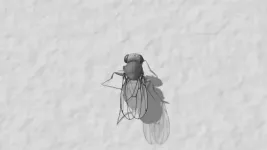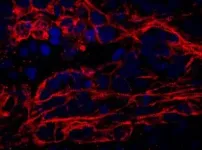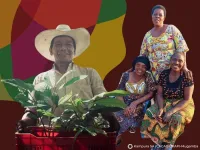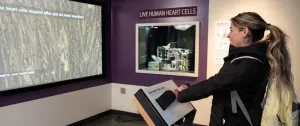(Press-News.org) When we walk down the street, we have an internal sense of which way we are heading, from looking at street signals and physical landmarks, and also a sense of where we’d like to go. But how does the brain coordinate between these directions, doing the mental math that tells us which way to turn?
Now, new research describes such a neural process in fruit flies, providing insight into how an animal’s brain steers it in the right direction. The study, published in Nature , shows how neurons that signal the direction in which a fly is currently oriented work together with neurons that signal the direction in which way the fly wishes to be oriented—its goal direction—to form a circuit that guides the animal.
“The fundamental question is how brains enable navigation,” says Rockefeller’s Gaby Maimon. “In this study, we describe neurons that provide goal-direction signals, alongside a brain circuit that uses these signals to direct steering.”
Navigational goals
The cells responsible for signaling which way a fly is oriented in the world (known as “compass” neurons) were first discovered in 2015. A few years later, work from the Maimon lab and others demonstrated that flies with defective compass neurons are unable to navigate in a straight line along any arbitrary goal direction. Building on that discovery, Peter Mussells Pires, a student in Maimon’s lab and the lead author on this paper, set out to discover the cells responsible for keeping track of a fly’s goal angle.
Pires and colleagues used two-photon microscopy to monitor flies’ neurons while the insects walked on an air-levitated ball in a virtual environment. Whenever the researchers rotated the virtual environment, the activity of the fly’s compass neurons rotated in the brain as well. Interestingly, however, a population of cells, identified as FC2 neurons, remained unmoved and focused on the original heading.
“Imagine walking uptown in Manhattan, and someone pulls your shoulder and turns you east. Something in your brain continues to track which way is north, so that you can return to your original heading,” Maimon explains. “In flies, these are FC2 neurons.”
To confirm the role of FC2 neurons in tracking a goal, the team used optogenetics—a technique that uses light to control the activity of neurons. By manipulating the activity of FC2 cells, the researchers were able to change the fly’s navigation direction in predictable ways. “This was the experiment that really convinced us that these cells can actually determine the fly’s goal,” Pires says.
Mental math
With heading neurons and goal neurons identified, the team shifted its focus to the brain circuit responsible for combining the two signals. Recent work fleshing out the fly brain connectome—a map detailing the connections between different neurons—helped the researchers zero in on the circuit in question. The connectome made clear that a set of cells, called PFL3 cells, receive inputs from both the compass and goal neurons.
A series of experiments confirmed that PFL3 neurons tell the fly’s body which way to turn by influencing the brain’s motor system. They do so by comparing internal heading and goal inputs, functioning a bit like the steering wheel of the fly’s navigation system. Larry Abbott, a theorist at Columbia University, collaborated with the team to develop a mathematical understanding of the system. Abbott’s model captured how compass and goal signals, which are represented in world or map coordinates (for example, north/east/south/west), are converted into motor-related signals in the body’s coordinate system—that is, left and right turns. Complementary results on PFL neurons, closely tied to the present study, are detailed in a parallel Nature paper.
Future work from the Maimon lab will focus on how flies build and store longer term spatial memories and goals to guide behavior; the goal signal characterized in this study only explains what the flies will do in the next few seconds. Maimon is also curious to learn whether these new findings might catalyze the discovery of similar brain circuits in mammals and ultimately humans.
“By studying the fly brain”, he says, “we have provided an initial glimpse into how a simple ‘thought’ is converted into an action. Hopefully, these findings will allow us to understanding more complex forms of this process in mammals down the road.”
END
How fruit flies control the brain's "steering wheel"
2024-02-08
ELSE PRESS RELEASES FROM THIS DATE:
SwRI’s Dr. Alan Stern named AIAA Fellow
2024-02-08
SAN ANTONIO — February 8, 2024 —Dr. Alan Stern, a planetary scientist and associate vice president of Southwest Research Institute’s Space Sector, has been named a Fellow of the American Institute of Aeronautics and Astronautics (AIAA). Fellows are recognized for their notable and valuable contributions to the arts, sciences or technology of aeronautics and astronautics. AIAA cited Stern “for outstanding contributions to the exploration of the solar system and the development of commercial spaceflight.”
“I am honored beyond words to be named an AIAA Fellow and thank my nominators very much, including SwRI Vice President Dr. Ben Thacker, who led the nomination,” ...
Visualising multiple sclerosis with a new MRI procedure
2024-02-08
Multiple sclerosis (MS) is a neurological disease that usually leads to permanent disabilities. It affects around 2.9 million people worldwide, and around 15,000 in Switzerland alone. One key feature of the disease is that it causes the patient’s own immune system to attack and destroy the myelin sheaths in the central nervous system. These protective sheaths insulate the nerve fibres, much like the plastic coating around a copper wire. Myelin sheaths ensure that electrical impulses travel quickly and efficiently from nerve cell to nerve cell. If they are damaged or become thinner, this can lead to irreversible visual, ...
Cacao of Excellence announces 2023 Cacao of Excellence gold, silver, and bronze award winners
2024-02-08
AMSTERDAM, NETHERLANDS (February 8, 2024) – Cacao of Excellence, a programme of the Alliance of Bioversity International and the International Center for Tropical Agriculture (CIAT) announced today the winners of the 2023 Cacao of Excellence Awards, honouring excellence in the cultivation of cacao, while also supporting and encouraging a more sustainable sector. The full list of Gold, Silver and Bronze winners can be found below and on the Cacao of Excellence website.
The winners were announced ...
How nearly identical RNA helicases drive “mRNA export” via distinct protein complex pathways
2024-02-08
Genetic expression, often leading to protein synthesis, requires a complex coordination of molecular machinery across several stages. A vital step in protein-coding gene expression is messenger RNA (mRNA) export, which involves shuttling mature mRNAs from the cell’s nucleus to the cytoplasm.
The mRNA export process relies on mRNA–protein complex formation, with the evolutionary conserved ATP-bound TREX complex playing a pivotal role. Among its components, the RNA helicase UAP56 is perhaps the most important one during its assembly. Not only does UAP56 participates during mRNA splicing in some transcripts, but it also recruits ...
Heart organoids simulate pregestational diabetes-induced congenital heart disease
2024-02-08
An advanced human heart organoid system can be used to model embryonic heart development under pregestational diabetes-like conditions, researchers report February 8 in the journal Stem Cell Reports. The organoids recapitulate hallmarks of pregestational diabetes-induced congenital heart disease found in mice and humans. The findings also showed that endoplasmic reticulum (ER) stress and lipid imbalance are critical factors contributing to these disorders, which could be ameliorated with exposure to omega-3s.
“The new stem cell-based organoid technology employed will enable physiologically relevant studies in humans, allowing us to bypass animal models and obtain more information ...
New study points to supply chain disruptions if the FDA removes ineffective decongestant from the market
2024-02-08
PITTSBURGH, Feb. 8, 2024 — In a new study of nasal decongestant purchasing patterns, researchers at the University of Pittsburgh School of Medicine found that phenylephrine remained the most popular choice year after year, despite decades of concerns over a lack of evidence supporting its effectiveness.
Published today in JAMA, the research letter points to a coming wave of supplychain disturbances if the Food and Drug Administration (FDA) moves to pull oral phenylephrine from the shelves, as recommended by an FDA advisory panel in 2023 that found the medication ineffective.
The researchers ...
Trends in phenylephrine and pseudoephedrine sales
2024-02-08
About The Study: Despite a lack of clinical efficacy evidence, phenylephrine was the most common oral decongestant in the U.S. from 2012-2021, with hundreds of millions of units purchased by retail pharmacies annually, and sales remained stable during this time. In contrast to pseudoephedrine, which is often formulated as a stand-alone product, most phenylephrine products were co-formulated with antihistamines or antitussives, which are likely to provide some symptom relief for cough and cold symptoms.
Authors: Timothy S. Anderson, M.D., M.A.S., of the University of Pittsburgh, is the corresponding author.
To access the embargoed study: Visit our For The Media website at ...
Visual impairment and real-world home physical activity with home environment in an older population
2024-02-08
About The Study: The results of this study demonstrated that home environment features, particularly lighting, may influence home activity metrics in older adults with visual impairment. Further prospective studies would be needed to confirm if home modifications can improve at-home activity.
Authors: Pradeep Y. Ramulu, M.D., M.H.S., Ph.D., of the Johns Hopkins University School of Medicine in Baltimore, is the corresponding author.
To access the embargoed study: Visit our For The Media website at this link https://media.jamanetwork.com/
(doi:10.1001/jamaophthalmol.2023.6436)
Editor’s Note: Please see the article for additional ...
Stigmatizing language on liver transplant center websites may discourage patients from seeking treatment
2024-02-08
BOSTON – The vast majority of liver transplant centers in the United States use language on their websites that can be considered stigmatizing through their use of words like “alcoholism,” “alcoholic” and “alcohol abuse,’ potentially hindering care and the willingness of patients to seek treatment, a study by Massachusetts General Hospital (MGH) has found.
In highlighting a significant gap between that online usage and the practice recommendations of medical ...
Heart-to-heart connection: Exploratorium and Gladstone bring a breakthrough science exhibit to life
2024-02-08
One of the country’s best-known science museums, San Francisco’s Exploratorium, is located less than three miles north of Gladstone Institutes—a proximity that has resulted in creative, high-science collaborations like the permanent exhibit featured in the latest issue of Stem Cell Reports.
Among the museum’s most popular exhibits, “Give Heart Cells A Beat” opens a rare window into the microscopic world of the beating human heart, using technology and materials made ...








